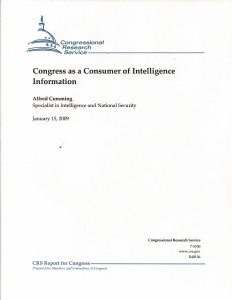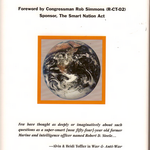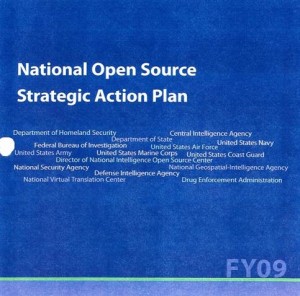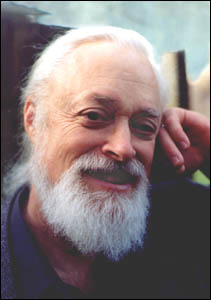Review: Africa Unchained–The Blueprint for Africa’s Future
Review: Dead Aid–Why Aid Is Not Working and How There Is a Better Way for Africa
Review: The Challenge for Africa
Review: The Trouble with Africa–Why Foreign Aid Isn’t Working
Below is a very important report that focuses primarily on Congress as a consumer of SECRET information. The report has yet to be written on Congressional needs for decision-support (intelligence) that is unclassified and can be shared with constituents, the press, and the private sector being regulated and taxed.

Click on the Frog to see a one-page listing of Congressional committees and how they would benefit from an Open Source Agency (OSA) that included Congress via the Congressional Research Service (CRS) as a primary stake-holder and recipient of unclassified decision-support. Conressional needs are also addressed by The Smart Nation Act: Public Intelligence in the Public Interest.



1. Needs to be redone and reissued without Doug Naquin’s signature. The delegation of authority to him is in violation of both ICD 300 and ICD 301.
2. The Vision is flawed because it focused only on security. Whole of Government needs for OSINT span the full range of ten high-level threats to humanity and the twelve core policies that need to be harmonized, listed below to demonstrate the paucity of the CIA OSC version of vision.
High-Level Threats to Humanity: 01 Poverty;02 Infectious Disease;03 Environmental Degradation;04 Inter-State; 05 Civil War; 06 Genocide; 07 Other Atrocities; 08 Proliferation; 09 Terrorism; 10) Transnational Crime.
Twelve Core Policies for Harmonization: 01 Agriculture; 02 Diplomacy; 03 Economy; 04 Education; 05 Energy; 06 Family; 07 Health; 08 Immigration; 09 Juctice; 10 Security; 11 Society; 12 Water.
Any Open Source Officer (OSO) who cannot recide these from memory and relate them to the mission of the US National Intelligence Community as outlined in the National Intelligence Strategy, should be assigned to less-demanding administrative duties.
The above can be used in conjunction with Secretary Gates’ statement that the military cannot do it all, and the Defense Science Board studies (all available at www.phibetaiota.net under References/DSB), to make the case for OSINT being a “360 degree” service that must meet the Mission Area needs of all of the elements of the Federal, State, and Local governments as well as regional constellations of mixed government and non-governmental organizations focused on challenges of common concern, e.g. Darfur, piracy, etcetera.
The illustration on page 5 is severely flawed in that it fails to integrate the OSINT needs and capabilities of all the federal non-security consumers at the same time that it assumes Homeland Security Enterprise will cover the non-security aspects of information sharing, and it ignores the Rest of the World both domestic and international.
The illustration on page 7 is severely flawed—a historic tendency of FBIS/OCS in that it assumes all OSINT is accessible via technical means. Humans and direct face to face interaction with Humans, is not part of the FBIS/OSC understanding.
The objectives on page 8 are laudable and not achievable as the IC OSINT enterprise is now organized and led. The integrated linguist activity is a particularly urgent need that is not understood nor properly defined in terms of online and human capabilities that could be harnessed.
A converstion is developing that will lead to a taxonomy for collective intelligence in all its forms, including public intelligence. Below is a first effort by Tom Atlee that decisively corrects our preliminary conclusion that public intelligence was the umbrella term.

Dear Robert,
I guess I'm stuck on what seems to me the straight-forward simplicity of “collective intelligence” as the overall category — as the intelligence capacity of any collective — family, group, organization, community, society, culture, network — they're all collectives (at least in my sense of the word). “Intelligence capacity” includes things like problem-solving, pattern recognition, analytic or integral model-making, learning (knowledge-building and revision), application of knowledge, insight, etc. — anything and everything having to do with engaging successfully with the patterns of reality. The different types of intelligence have diverse gifts to offer — different types of cognition needed to deal with certain types of patterns — e.g., Gardner's seven “multiple intelligences” (including emotional intelligence), on the one hand, or “business intelligence” and “street smarts” on the other. In this definition, at this level, I find “collective intelligence” to be totally embracive of the requisite diversity, and the term “public intelligence” to be awkward, at best (public as opposed to private?).
However, there's a whole ‘nother framing from which to view this, which I sense is your “home base” — “the craft of intelligence (as in “intelligence agency”). I see the “craft of intelligence” (as a specific sub-category of the broader CAPACITY of intelligence, in this case focused on the collective practice of gathering, sorting, organizing, and analyzing data into useful patterns (information, understanding, narratives, meaning) for decision-makers. With this definition, at this level, the term “public intelligence” means to me the publicly visible and highly participatory practice of doing that for democratic decision-makers who, in the fullest democratic sense, includes or is the public, itself (the citizenry), who are practicing intelligence to inform their own empowered decision-making.
So public intelligence is, for me, a subset of collective intelligence. Much of my “wise democracy” work can be squeezed into the “public intelligence” category. But I have also framed collective intelligence more broadly and think of my larger work as being largely involved with that broader category.
“Co-intelligence” is a larger category still, involving the interactive, collaborative intelligence of the whole (which can be a group, but it can also be an event, nature, evolution, the universe, or Spirit).
I hope that's useful, at least in terms of where to place me in the weave you're creating…
Co-heartedly,Tom
We urge one and all to support Tom Atlee's gentle intelligent efforts to restore the Collective Intelligence that is inherent in humanity as a Whole. Visit him at the Co-Intelligence Institute and make your donation there, please.


Stephen E. Arnold is an independent consultant. He's the author of The Google Legacy: How Search Became the New Application Platform, the first three editions of the Enterprise Search Report, and Google Version 2.0: The Calculating Predator. His work has been distributed by Bear Stearns and Outsell Inc. This information is based on research for this forthcoming study, Beyond Search: What to Do When Your Search System Doesn't Work, Gilbane Group, 2008. His Web site is www.arnoldit.com.
Search panacea or ploy:
Can collective intelligence improve findability?